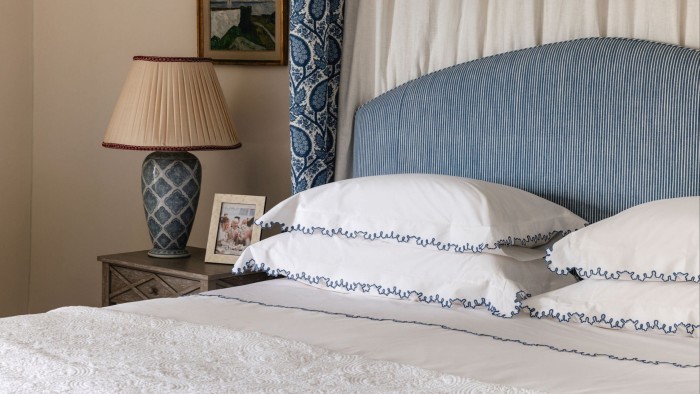Unlock the Editor’s Digest for free
Roula Khalaf, Editor of the FT, selects her favourite stories in this weekly newsletter.
I always prepare myself for some level of discomfort when travelling to new countries but I never would have expected to be so befuddled by American bedding. I have lived in the US for almost 15 years now and I’m constantly confounded by the country’s obsession with bedsheets. It began on my very first night in the States. After a long day of travel I arrived in NYC drunk on the idea of sleep. I excitedly peeled back the duvet only to reveal my newest foe. The top sheet.
Having never been acquainted with this additional fabric layer betwixt bottom sheet and duvet, I assumed it was a mistake. Until, that is, I noticed the obvious care that had been taken in tucking in the sides while leaving the top folded over the duvet. I’m adventurous, I can try new things, I thought to myself. I threw caution and common sense to the wind and squeezed myself into the limited space between this extra sheet and the actually functional one atop the mattress, like how I imagined an inexperienced spelunker cautiously enters their first crevice, not knowing if they will ever make it out. I tried to get comfortable, but it’s hard when trapped.
I decided to untuck the sides, thus forcing myself to contend with loose and unruly material wrapping itself around my limbs whenever I tried to move. Eventually I managed to manoeuvre it down to the bottom of the bed so that only my feet were swaddled. When I awoke in the morning, I found it where it truly belongs: crumpled on the floor.
To top sheet or not to top sheet is a matter, it turns out, of much heated discussion. In 2019, mattress brand Casper surveyed 1,000 Americans to put “the Top Sheet Debate to Bed”. Their conclusion was that 58 per cent of Americans agree or strongly agree that a top sheet is essential, with those aged 55 and older most in favour (67 per cent). But, still, TikTok is awash with passionate pleas both for — with tips on how to tuck just so — and against. In a post by Pitchfork, one of the singers of Boygenius, Phoebe Bridgers, is disgusted by the mere implication that someone would sleep without one while her bandmates insist that sleeping with only a comforter is perfectly fine.
I have heard countless arguments in the defence of the top sheet, the most commonly echoed one being that it is more hygienic. And our mania to sanitise has only been exacerbated by Covid. In 2024, an article by Better Homes & Gardens (a magazine first launched in 1922 in Des Moines, Iowa) declared: “A top sheet on your bed is essential for hygiene and comfort.”
Essential? I understand that at one point, when we still slept under itchy, mite-infested woollen blankets, the top sheet was crucial in guaranteeing a comfortable night’s sleep. But those days are done. We also used to sleep on stone pillows and mattresses made of hay. We’ve moved on.
Do you know what else is hygienic? Washing a duvet cover. Listen, I understand how daunting duvets can be; I once became trapped in a cover as a child while attempting to put it on the duvet. I still shudder when I recall the pink and white stripes I thought had become my tomb. But I overcame my fears just like germaphobes can overcome theirs.
Canadian writer Katherine Ashenburg once wrote that in the US “good hygiene had other virtues: it was a way to mark status and civility in a country without an aristocracy, and it could “Americanise” the hundreds of thousands of Europeans who began arriving in the 1880s”. As a dirty European from an aristocratic nation, maybe I’m not without bias but I think the obsession with “hygiene” has been taken too far.
I’m not alone. In the 1980s, professor of epidemiology David P Strachan first posited the “hygiene hypothesis”, which suggests that childhood exposure to germs can strengthen a child’s immune system. In 2016, microbiologists B Brett Finlay and Marie-Claire Arrieta offered “Let Them Eat Dirt: Saving Your Child from an Oversanitized World”, a plea against our too-clean culture. Those antibacterial wipes could be playing havoc with your microbiome.
Top sheets are, to my mind, tightly tied in with this obsession with hygiene. But there’s also, of course, an aesthetic side to the top sheet. They lend an undeniable, hotel-like neatness. It’s like putting a ribbon on an already perfectly wrapped present. Every night. On the same present. It’s excessive.
The cult of the perfectly made bed is out of control. The US bedsheets market is booming (forecast to grow from $8.06bn in 2025 to $11.55bn by 2032). Ditto decorative pillows (a market that in the US was $3.83bn in 2024 and is projected to increase to $6.47bn by 2033). I’m just not down with all these extra frills. As much as the US seems to be regressing back to the 1950s, our bedrooms can be a place free of old-fashioned trappings. Not to mention extra washing. If Marie Kondo, the queen of tidying herself, has admitted that she’s kind of given up on trying to keep everything spick and span, maybe it’s time for us to ease up on it too. And the first step should be to finally do away with the top sheet.
Find out about our latest stories first — follow @ft_houseandhome on Instagram
